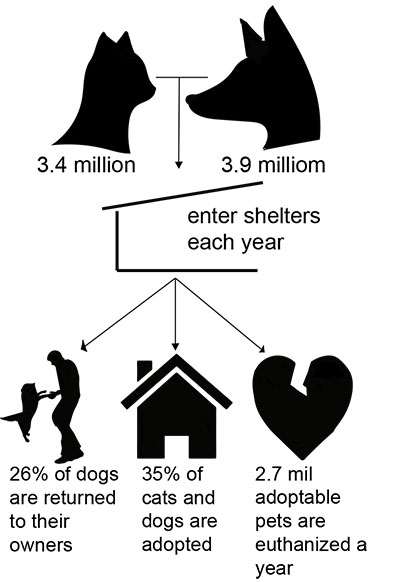Gas chamber euthanasia

Photo by Illustration by Tate Bailey
September 27, 2016
Seven million six hundred thousand dogs and cats enter shelters each year. Only one third of these animals will leave.
On average 2.6 million animals are euthanized every year. Methods of euthanasia include using lethal injections (EBIs) or carbon monoxide gas chambers.
The use of gas chambers is discouraged and protested by many organizations like the Humane Society, People for the Ethical Treatment of Animals, American Soceity for the Prevention of Cruelty to Animals and more. Twenty three states in the U.S do not have a formal ban against the use of carbon monoxide gas chambers. Indiana is among these states.
Indiana official law prohibits euthanasia by electrocution and compression stating, “ A person who knowingly or intentionally destroys or authorizes the destruction of an animal by: (1) placing the animal in a decompression chamber and lowering the pressure of or the oxygen content in the air surrounding the animal; or (2) electrocution; commits a Class B misdemeanor.”
Euthanasia by gas chambers is not illegal in Indiana.
Gas chambers are small boxes in which animals are exposed to lethal amounts of carbon monoxide or dioxide. Often times these boxes contain multiple animals.
According to the Humane Society of the United States, “For several minutes, they may be in the box, terrified, clawing and calling for a way out. They may struggle for air or begin convulsing before finally losing consciousness.”
In some cases an animal’s vital organs will begin shutting down while they are still lucid.
“Some animals survive the first round and are put through this horrific process a second time,” according to Animal Aid U.S.A.
A study conducted by the American Humane Association (AHA) states, “The cost to use carbon monoxide poisoning is $4.98 per animal. The cost to use EBI, however, is only $2.29 per animal.”
This only applies when one animal is inside the chamber. Fitting multiple animals inside of a gas chamber makes carbon monoxide gas methods less expensive than EBIs.
“Abuse of the chamber is common. In many cases animals are simply shoved into the chamber, the door sealed, the button pushed, and the employee walks away, resulting in a slow, painful death for the animals,” as stated by Animal Law Resource Center.
Shelters like the Humane Society for Hamilton County use Sodium Pentobarbital to euthanize animals that are extremely sick or elderly.
“When injected into a vein, this drug produces rapid unconsciousness and death without the pain and distress that accompany all other methods,” according to Animal Law Resource Center.
If residents of Hamilton County wish to put a stop to the use of gas chamber euthanasia, they can donate to their local Humane Society which advocates against the practice of using gas chambers.
Read more about the Humane Society in The 7.6 and More Pity, Less Bull.


